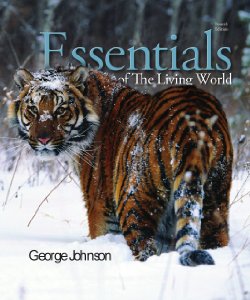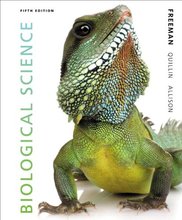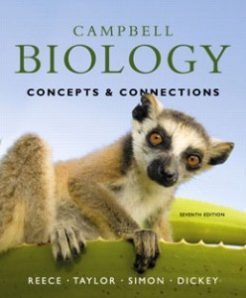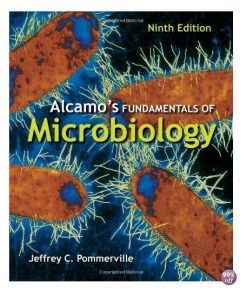Description
***THIS IS NOT THE ACTUAL BOOK. YOU ARE BUYING the Test Bank in e-version of the following book***
Title: Test Bank for Essentials of The Living World 4th Edition George Johnson Download
Edition: 4th Edition
ISBN-10: 0073525472
ISBN-13: 978-0073525471
– The test bank is what most professors use an a reference when making exams for their students, which means there’s a very high chance that you will see a very similar, if not exact the exact, question in the test!
– The file is either in pdf, doc, rtf or zipped in the package and can easily be read on PCs and Macs.
– Delivery is INSTANT. You can download the files IMMEDIATELY once payment is done.
We also faced similar difficulities when we were students, and we understand how you feel.
But now, with the Test Bank for Essentials of The Living World 4th Edition George Johnson Download, you will be able to
* Anticipate the type of the questions that will appear in your exam.
* Reduces the hassle and stress of your student life.
* Improve your studying and also get a better grade!
* Get prepared for examination questions.
* Can save you time and help you understand the material.
This is the quality of service we are providing and we hope to be your helper.
Delivery is in the next moment. Test Bank is accurate.
If you have any questions, or would like a receive a sample chapter before your purchase, please contact us at inquiry@testbankcorp.com
Chapter 03 Test Bank
Student: ___________________________________________________________________________
1. Which level of protein structure ultimately determines all the other levels of structure?
A. Primary
B. Secondary
C. Tertiary
D. Quaternary
2. Hydrogen bonds between different parts of the polypeptide chain result in which level of protein structure?
A. Primary
B. Secondary
C. Tertiary
D. Quaternary
3. The final three-dimensional shape of a protein is its ____________ structure.
A. Primary
B. Secondary
C. Tertiary
D. Quaternary
4. When a protein is composed of more than one polypeptide chain, the arrangement of the chains is called the ____________ structure.
A. primary
B. secondary
C. tertiary
D. quaternary
5. Enzymes function to
A. add structural support.
B. provide defense.
C. transport molecules.
D. make chemical reactions more like to occur.
6. The ?-helix and ?-pleated sheet are examples of which level of protein structure?
A. Primary
B. Secondary
C. Tertiary
D. Quaternary
7. When a protein is denatured, which level of protein structure is unaffected?
A. Primary
B. Secondary
C. Tertiary
D. Quaternary
8. Which polymer serves as the information storage molecule for cells?
A. Carbohydrate
B. Nucleic acid
C. Protein
D. Lipids
9. If one strand is CCAATTG on DNA then the complementary chain is
A. CCAATTG.
B. AAGGUUC.
C. GGUUAAC.
D. GGTTAAC.
E. It is impossible to determine.
10. The bases of the two DNA chains are linked in the middle of the molecule by _________ bonds.
A. covalent
B. ionic
C. hydrogen
D. There are no bonds connecting the chains.
11. Which of the following is not true?
A. There are 20 common amino acids that make up proteins.
B. The amount of adenine equals the amount of thymine and the amount of cytosine equals the amount of guanine.
C. Lipids are not water soluble.
D. The ratio of carbon atoms to hydrogen atoms to oxygen atoms is 1:2:1 in carbohydrates.
E. Macromolecules are formed by hydrolysis reactions.
12. The carbohydrate that plants use to store energy is called
A. starch.
B. cellulose.
C. fructose.
D. sucrose.
E. chitin.
13. The carbohydrate that is found in plant cell walls is
A. starch.
B. cellulose.
C. chitin.
D. fructose.
E. sucrose.
14. A polysaccharide of glucose found in animals that is highly branched is
A. starch.
B. cellulose.
C. chitin.
D. glycogen.
E. sucrose.
15. The external skeleton of many invertebrates is made of
A. starch.
B. cellulose.
C. chitin.
D. glycogen.
E. sucrose.
16. Fats composed of fatty acids that have double bonds in the fatty acids and have fewer than the maximum number of hydrogen atoms are
A. saturated.
B. liquids at room temperature.
C. solid at room temperature.
D. generally found in animal fats.
17. Which of the following is incorrect about saturated fats?
A. They are solid at room temperature.
B. They contain the maximum number of hydrogen atoms.
C. They contain glycerol plus 3 fatty acids.
D. They are nonpolar molecules that don’t mix with water.
E. They are generally the type of fat found in plants.
18. All of the following are lipids except
A. waxes.
B. cholesterol.
C. female sex hormones.
D. phospholipids.
E. glycogen.
19. Which of the following is a main component of cell membranes?
A. Cellulose
B. Sucrose
C. Phospholipids
D. Triglycerides
E. Glycogen
20. The sugar found in RNA is
A. lactose.
B. glucose.
C. ribose.
D. deoxyribose.
E. glycogen.
21. Which is incorrect about proteins?
A. The main function of proteins is energy storage.
B. Proteins can be enzymes.
C. Proteins are polymers of amino acids.
D. The sequence of amino acids determines the primary structure of the protein.
E. Some proteins have a transport function.
22. The building blocks of carbohydrates are
A. amino acids.
B. polypeptides.
C. monosaccharides.
D. nucleotides.
23. Animals store energy in a polymer composed of many glucose molecules called
A. starch.
B. glycogen.
C. cellulose.
D. chitin.
24. Fatty acids that contain the maximum number of hydrogen atoms possible are said to be
A. polyunsaturated.
B. monounsaturated.
C. saturated.
D. phospholipids.
25. Proteins are made up of ____________ strung together by _________ bonds.
A. amino acids; peptide
B. monosaccharides; nucleotide
C. monomers; ionic
D. polymers; hydrogen
26. Making and breaking molecules in the body require the aid of ____________ to help the reactions proceed.
A. heat
B. water
C. blood
D. enzymes
27. Glucose is a type of carbohydrate called _____________.
A. a polysaccharide
B. a disaccharide
C. a monosaccharide
D. a nucleotide
28. Choose the statement that is true about DNA.
A. It exhibits base pairing.
B. It forms a double helix.
C. It is a polymer of nucleotides.
D. All of these are correct.
29. All of the following are ways RNA differs from DNA except
A. RNA is single stranded.
B. RNA is a nucleic acid.
C. RNA contains ribose.
D. RNA contains uracil.
30. Denaturation of proteins is always a reversible process.
True False
31. Lipids are insoluble in water because they are nonpolar.
True False
32. Unsaturated fats are usually solid at room temperature.
True False
33. The sequence of nucleotides in DNA specifies the sequence of ________________ in a protein.
________________________________________
34. In RNA, thymine is replaced with ___________.
________________________________________
35. A __________ bond links two amino acids together.
________________________________________
36. Nucleic acids are long polymers of repeating subunits called ___________.
________________________________________
37. The polysaccharide found in the cell walls of plants is ___________.
________________________________________
38. Many mammals supply energy to their young in the form of ___________.
________________________________________
39. List the four major types of macromolecules, their subunits (building blocks), and their functions.
40. Compare saturated and unsaturated fats with regard to source, structure, and consistency.
41. Describe the four levels of protein structure and how they are affected by denaturation.
42. Describe five functions of proteins.
43. Describe the structure of DNA.
Chapter 03 Test Bank Key
1. Which level of protein structure ultimately determines all the other levels of structure?
A. Primary
B. Secondary
C. Tertiary
D. Quaternary
Bloom’s Level: 1. Remember
Learning Outcome: 03.02.03 Describe the four general levels of protein structure, and how the polar nature of water influences them.
Section: 03.02
Topic: Chemistry
2. Hydrogen bonds between different parts of the polypeptide chain result in which level of protein structure?
A. Primary
B. Secondary
C. Tertiary
D. Quaternary
Bloom’s Level: 1. Remember
Learning Outcome: 03.02.03 Describe the four general levels of protein structure, and how the polar nature of water influences them.
Section: 03.02
Topic: Chemistry
3. The final three-dimensional shape of a protein is its ____________ structure.
A. Primary
B. Secondary
C. Tertiary
D. Quaternary
Bloom’s Level: 1. Remember
Learning Outcome: 03.02.03 Describe the four general levels of protein structure, and how the polar nature of water influences them.
Section: 03.02
Topic: Chemistry
4. When a protein is composed of more than one polypeptide chain, the arrangement of the chains is called the ____________ structure.
A. primary
B. secondary
C. tertiary
D. quaternary
Bloom’s Level: 1. Remember
Learning Outcome: 03.02.03 Describe the four general levels of protein structure, and how the polar nature of water influences them.
Section: 03.02
Topic: Chemistry
5. Enzymes function to
A. add structural support.
B. provide defense.
C. transport molecules.
D. make chemical reactions more like to occur.
Bloom’s Level: 1. Remember
Learning Outcome: 03.02.05 Describe how the structure of an enzyme enables it to catalyze a chemical reaction.
Section: 03.02
Topic: Chemistry
6. The ?-helix and ?-pleated sheet are examples of which level of protein structure?
A. Primary
B. Secondary
C. Tertiary
D. Quaternary
Bloom’s Level: 1. Remember
Learning Outcome: 03.02.03 Describe the four general levels of protein structure, and how the polar nature of water influences them.
Section: 03.02
Topic: Chemistry
7. When a protein is denatured, which level of protein structure is unaffected?
A. Primary
B. Secondary
C. Tertiary
D. Quaternary
Bloom’s Level: 2. Understand
Learning Outcome: 03.02.04 Explain the forces that cause a protein to denature.
Section: 03.02
Topic: Chemistry
8. Which polymer serves as the information storage molecule for cells?
A. Carbohydrate
B. Nucleic acid
C. Protein
D. Lipids
Bloom’s Level: 1. Remember
Learning Outcome: 03.03.02 State the two major chemical differences between DNA and RNA.
Section: 03.03
Topic: Chemistry
9. If one strand is CCAATTG on DNA then the complementary chain is
A. CCAATTG.
B. AAGGUUC.
C. GGUUAAC.
D. GGTTAAC.
E. It is impossible to determine.
Bloom’s Level: 2. Understand
Learning Outcome: 03.03.03 Identify what two base pairings are possible in DNA, and explain why the other four potential base pairings do not occur.
Section: 03.03
Topic: Chemistry
10. The bases of the two DNA chains are linked in the middle of the molecule by _________ bonds.
A. covalent
B. ionic
C. hydrogen
D. There are no bonds connecting the chains.
Bloom’s Level: 1. Remember
Learning Outcome: 03.03.03 Identify what two base pairings are possible in DNA, and explain why the other four potential base pairings do not occur.
Section: 03.03
Topic: Chemistry
11. Which of the following is not true?
A. There are 20 common amino acids that make up proteins.
B. The amount of adenine equals the amount of thymine and the amount of cytosine equals the amount of guanine.
C. Lipids are not water soluble.
D. The ratio of carbon atoms to hydrogen atoms to oxygen atoms is 1:2:1 in carbohydrates.
E. Macromolecules are formed by hydrolysis reactions.
Bloom’s Level: 2. Understand
Learning Outcome: 03.05.01 Distinguish between saturated and unsaturated fats, and explain why one is a solid and the other a liquid at room temperature.
Section: 03.01
Topic: Chemistry
12. The carbohydrate that plants use to store energy is called
A. starch.
B. cellulose.
C. fructose.
D. sucrose.
E. chitin.
Bloom’s Level: 1. Remember
Learning Outcome: 03.04.01 Define carbohydrate. Distinguish between monosaccharides and polysaccharides.
Section: 03.04
Topic: Chemistry
13. The carbohydrate that is found in plant cell walls is
A. starch.
B. cellulose.
C. chitin.
D. fructose.
E. sucrose.
Bloom’s Level: 1. Remember
Learning Outcome: 03.04.01 Define carbohydrate. Distinguish between monosaccharides and polysaccharides.
Section: 03.04
Topic: Chemistry
14. A polysaccharide of glucose found in animals that is highly branched is
A. starch.
B. cellulose.
C. chitin.
D. glycogen.
E. sucrose.
Bloom’s Level: 1. Remember
Learning Outcome: 03.04.01 Define carbohydrate. Distinguish between monosaccharides and polysaccharides.
Section: 03.04
Topic: Chemistry
15. The external skeleton of many invertebrates is made of
A. starch.
B. cellulose.
C. chitin.
D. glycogen.
E. sucrose.
Bloom’s Level: 1. Remember
Learning Outcome: 03.04.01 Define carbohydrate. Distinguish between monosaccharides and polysaccharides.
Section: 03.04
Topic: Chemistry
16. Fats composed of fatty acids that have double bonds in the fatty acids and have fewer than the maximum number of hydrogen atoms are
A. saturated.
B. liquids at room temperature.
C. solid at room temperature.
D. generally found in animal fats.
Bloom’s Level: 1. Remember
Learning Outcome: 03.05.01 Distinguish between saturated and unsaturated fats, and explain why one is a solid and the other a liquid at room temperature.
Section: 03.05
Topic: Chemistry
17. Which of the following is incorrect about saturated fats?
A. They are solid at room temperature.
B. They contain the maximum number of hydrogen atoms.
C. They contain glycerol plus 3 fatty acids.
D. They are nonpolar molecules that don’t mix with water.
E. They are generally the type of fat found in plants.
Bloom’s Level: 2. Understand
Learning Outcome: 03.05.01 Distinguish between saturated and unsaturated fats, and explain why one is a solid and the other a liquid at room temperature.
Section: 03.05
Topic: Chemistry
18. All of the following are lipids except
A. waxes.
B. cholesterol.
C. female sex hormones.
D. phospholipids.
E. glycogen.
Bloom’s Level: 1. Remember
Learning Outcome: 03.05.01 Distinguish between saturated and unsaturated fats, and explain why one is a solid and the other a liquid at room temperature.
Section: 03.05
Topic: Chemistry
19. Which of the following is a main component of cell membranes?
A. Cellulose
B. Sucrose
C. Phospholipids
D. Triglycerides
E. Glycogen
Bloom’s Level: 1. Remember
Learning Outcome: 03.05.01 Distinguish between saturated and unsaturated fats, and explain why one is a solid and the other a liquid at room temperature.
Section: 03.05
Topic: Chemistry
20. The sugar found in RNA is
A. lactose.
B. glucose.
C. ribose.
D. deoxyribose.
E. glycogen.
Bloom’s Level: 1. Remember
Learning Outcome: 03.03.02 State the two major chemical differences between DNA and RNA.
Section: 03.03
Topic: Chemistry
21. Which is incorrect about proteins?
A. The main function of proteins is energy storage.
B. Proteins can be enzymes.
C. Proteins are polymers of amino acids.
D. The sequence of amino acids determines the primary structure of the protein.
E. Some proteins have a transport function.
Bloom’s Level: 2. Understand
Learning Outcome: 03.02.02 Diagram the structure of an amino acid, and the formation of a peptide bond.
Section: 03.02
Topic: Chemistry
22. The building blocks of carbohydrates are
A. amino acids.
B. polypeptides.
C. monosaccharides.
D. nucleotides.
Bloom’s Level: 1. Remember
Learning Outcome: 03.01.01 Distinguish between a polymer and a monomer.
Section: 03.01
Section: 03.04
Topic: Chemistry
23. Animals store energy in a polymer composed of many glucose molecules called
A. starch.
B. glycogen.
C. cellulose.
D. chitin.
Bloom’s Level: 1. Remember
Learning Outcome: 03.04.01 Define carbohydrate. Distinguish between monosaccharides and polysaccharides.
Section: 03.04
Topic: Chemistry
24. Fatty acids that contain the maximum number of hydrogen atoms possible are said to be
A. polyunsaturated.
B. monounsaturated.
C. saturated.
D. phospholipids.
Bloom’s Level: 1. Remember
Learning Outcome: 03.05.01 Distinguish between saturated and unsaturated fats, and explain why one is a solid and the other a liquid at room temperature.
Section: 03.05
Topic: Chemistry
25. Proteins are made up of ____________ strung together by _________ bonds.
A. amino acids; peptide
B. monosaccharides; nucleotide
C. monomers; ionic
D. polymers; hydrogen
Bloom’s Level: 1. Remember
Learning Outcome: 03.02.02 Diagram the structure of an amino acid, and the formation of a peptide bond.
Section: 03.02
Topic: Chemistry
26. Making and breaking molecules in the body require the aid of ____________ to help the reactions proceed.
A. heat
B. water
C. blood
D. enzymes
Bloom’s Level: 1. Remember
Learning Outcome: 03.01.02 Contrast hydrolysis with dehydration synthesis.
Section: 03.01
Topic: Chemistry
27. Glucose is a type of carbohydrate called _____________.
A. a polysaccharide
B. a disaccharide
C. a monosaccharide
D. a nucleotide
Bloom’s Level: 1. Remember
Learning Outcome: 03.04.01 Define carbohydrate. Distinguish between monosaccharides and polysaccharides.
Section: 03.04
Topic: Chemistry
28. Choose the statement that is true about DNA.
A. It exhibits base pairing.
B. It forms a double helix.
C. It is a polymer of nucleotides.
D. All of these are correct.
Bloom’s Level: 2. Understand
Learning Outcome: 03.03.03 Identify what two base pairings are possible in DNA, and explain why the other four potential base pairings do not occur.
Section: 03.03
Topic: Chemistry
29. All of the following are ways RNA differs from DNA except
A. RNA is single stranded.
B. RNA is a nucleic acid.
C. RNA contains ribose.
D. RNA contains uracil.
Bloom’s Level: 2. Understand
Learning Outcome: 03.03.02 State the two major chemical differences between DNA and RNA.
Section: 03.03
Topic: Chemistry
30. Denaturation of proteins is always a reversible process.
FALSE
Bloom’s Level: 2. Understand
Learning Outcome: 03.02.04 Explain the forces that cause a protein to denature.
Section: 03.02
Topic: Chemistry
31. Lipids are insoluble in water because they are nonpolar.
TRUE
Bloom’s Level: 2. Understand
Learning Outcome: 03.05.01 Distinguish between saturated and unsaturated fats, and explain why one is a solid and the other a liquid at room temperature.
Section: 03.05
Topic: Chemistry
32. Unsaturated fats are usually solid at room temperature.
FALSE
Bloom’s Level: 2. Understand
Learning Outcome: 03.05.01 Distinguish between saturated and unsaturated fats, and explain why one is a solid and the other a liquid at room temperature.
Section: 03.05
Topic: Chemistry
33. The sequence of nucleotides in DNA specifies the sequence of ________________ in a protein.
amino acids
Bloom’s Level: 2. Understand
Learning Outcome: 03.03.01 Name the three parts of a nucleotide.
Section: 03.03
Topic: Chemistry
34. In RNA, thymine is replaced with ___________.
uracil
Bloom’s Level: 1. Remember
Learning Outcome: 03.03.02 State the two major chemical differences between DNA and RNA.
Section: 03.03
Topic: Chemistry
35. A __________ bond links two amino acids together.
peptide
Bloom’s Level: 1. Remember
Learning Outcome: 03.02.02 Diagram the structure of an amino acid, and the formation of a peptide bond.
Section: 03.02
Topic: Chemistry
36. Nucleic acids are long polymers of repeating subunits called ___________.
nucleotides
Bloom’s Level: 1. Remember
Learning Outcome: 03.03.01 Name the three parts of a nucleotide.
Section: 03.03
Topic: Chemistry
37. The polysaccharide found in the cell walls of plants is ___________.
cellulose
Bloom’s Level: 1. Remember
Learning Outcome: 03.04.01 Define carbohydrate. Distinguish between monosaccharides and polysaccharides.
Section: 03.04
Topic: Chemistry
38. Many mammals supply energy to their young in the form of ___________.
lactose
Bloom’s Level: 1. Remember
Learning Outcome: 03.04.01 Define carbohydrate. Distinguish between monosaccharides and polysaccharides.
Section: 03.04
Topic: Chemistry
39. List the four major types of macromolecules, their subunits (building blocks), and their functions.
Bloom’s Level: 1. Remember
Learning Outcome: 03.01.01 Distinguish between a polymer and a monomer.
Section: 03.01
Topic: Chemistry
40. Compare saturated and unsaturated fats with regard to source, structure, and consistency.
Bloom’s Level: 2. Understand
Learning Outcome: 03.05.01 Distinguish between saturated and unsaturated fats, and explain why one is a solid and the other a liquid at room temperature.
Section: 03.05
Topic: Chemistry
41. Describe the four levels of protein structure and how they are affected by denaturation.
Bloom’s Level: 1. Remember
Learning Outcome: 03.02.04 Explain the forces that cause a protein to denature.
Section: 03.02
Topic: Chemistry
42. Describe five functions of proteins.
Bloom’s Level: 1. Remember
Learning Outcome: 03.02.01 Explain what proteins do by listing five functional groupings of proteins.
Section: 03.02
Topic: Chemistry
43. Describe the structure of DNA.
Bloom’s Level: 1. Remember
Learning Outcome: 03.03.02 State the two major chemical differences between DNA and RNA.
Section: 03.03
Topic: Chemistry







Reviews
There are no reviews yet.